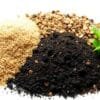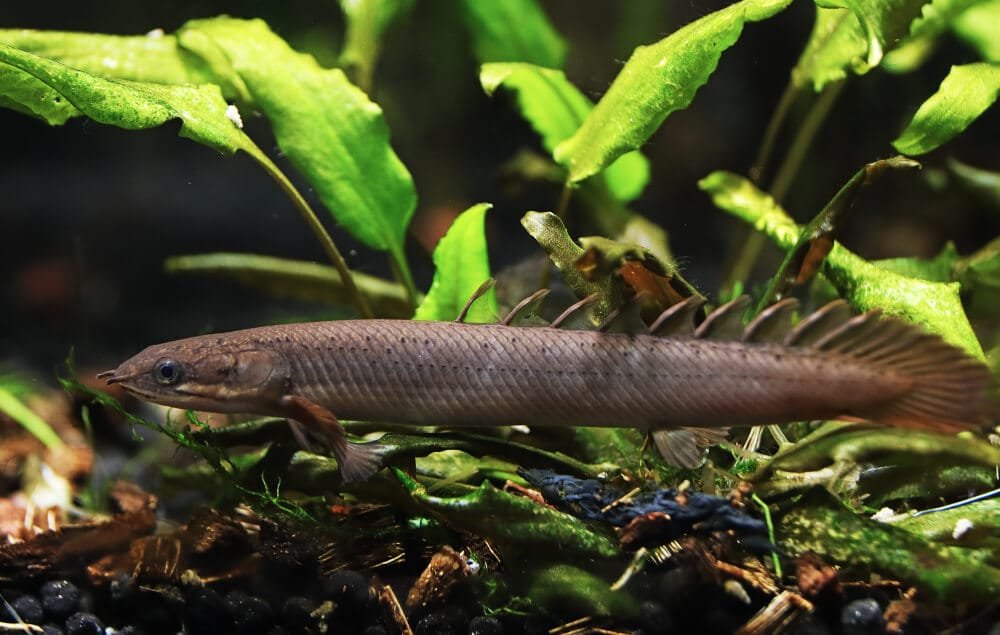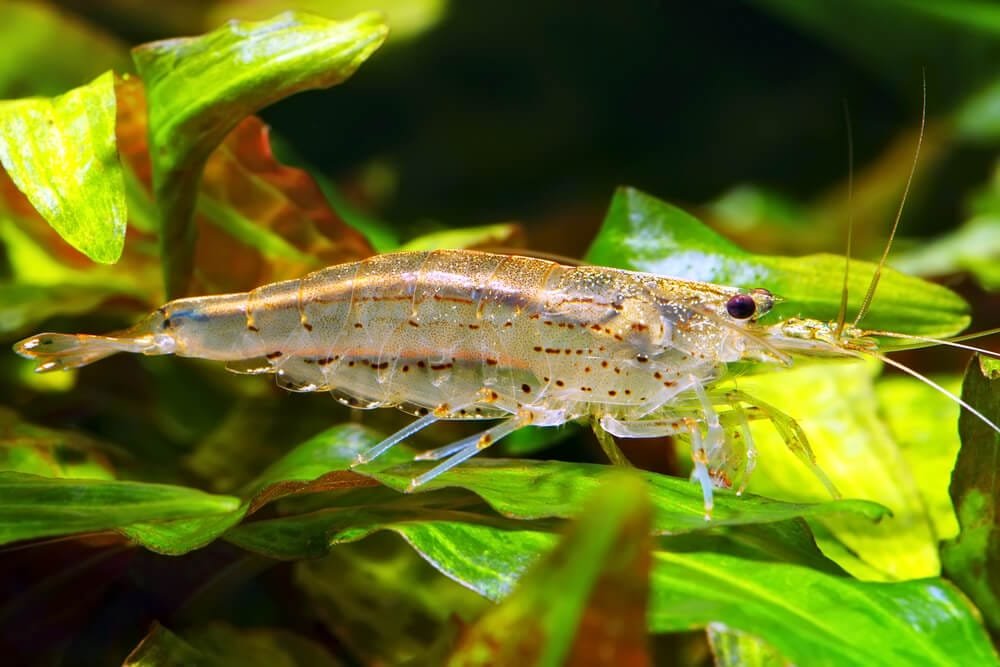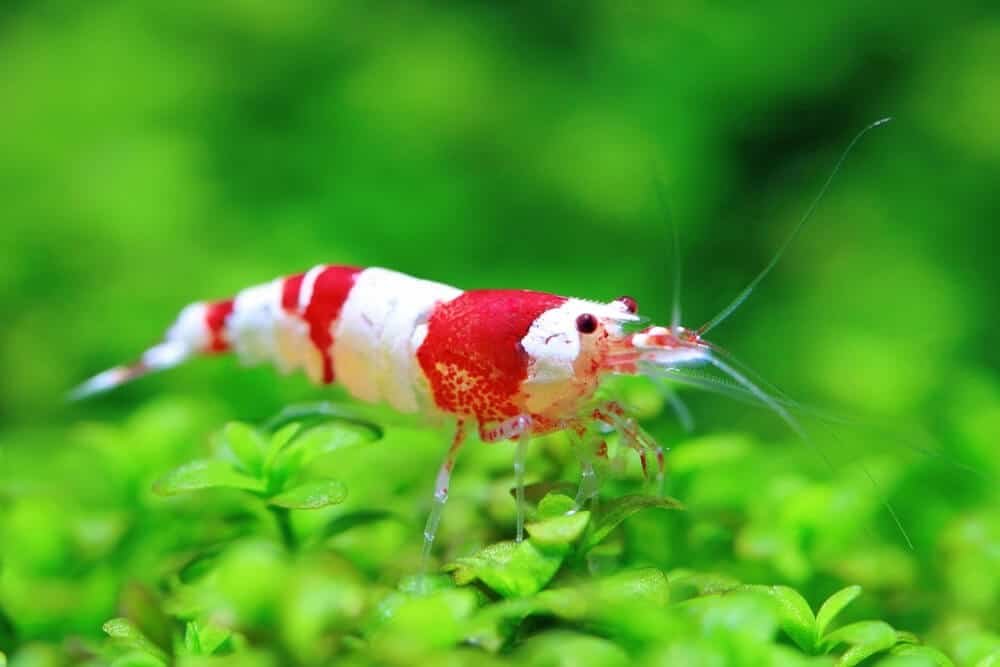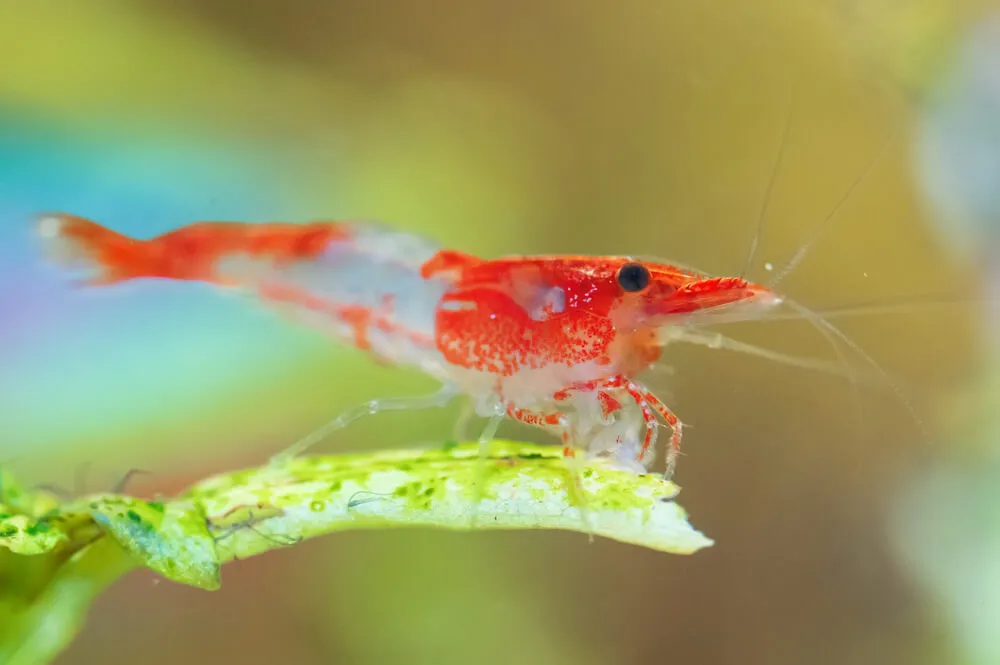Are you ready to turn your aquarium into a colorful masterpiece? The black galaxy pinto shrimp could be the perfect choice for your dwarf shrimp collection.
These tiny wonders are more than just small creatures. They are living pieces of art. Originating from Japan, pinto shrimp have become a favorite among aquarium lovers.
These shrimp are small but pack a big punch. They can grow up to 1 inch and have a unique genetic makeup. With a lifespan of 1-2 years, they add a special touch to your aquarium.
Keeping the water right is key for these shrimp. They need temperatures between 68-74°F and a pH of 5.8-6.8. This makes them a great choice for those looking to improve their aquarium skills.
Understanding Pinto Shrimp: Species Overview and Origins
Pinto shrimp are a unique mix of two amazing crustacean species. They come from a special breeding process. This process combines Caridina cantonensis with selected genetic lines.
Scientific Classification
The Pinto shrimp’s scientific background comes from Caridina and neocaridina breeding. They mix traits from Taiwan Bee shrimp and tiger shrimp. This mix creates stunning color patterns that aquarium fans love.
- Kingdom: Animalia
- Phylum: Arthropoda
- Class: Malacostraca
- Order: Decapoda
- Family: Atyidae
- Genus: Caridina
- Species: Caridina cantonensis “Pinto”
Natural Habitat and Distribution
Pinto shrimp were first bred in Japan and Taiwan. They are now sought after worldwide. Their ancestors come from East Asia’s freshwater areas. These areas have soft, slightly acidic water.
Physical Characteristics
Pinto shrimp are known for their striking black, white, and spotted looks. They grow up to 1 inch long. Their color patterns show off their unique genetic traits.
| Characteristic | Description |
|---|---|
| Maximum Size | 1 inch |
| Lifespan | 18 months average |
| Color Variation | Black and white spots, galaxy patterns |
| Pattern Complexity | High genetic variability |
“The beauty of Pinto shrimp lies in their unpredictable and mesmerizing genetic expressions.” – Shrimp Breeding Experts
Every Pinto shrimp is a unique piece of genetic art. No two have the same markings. Their complex genetics make them a hit with both aquarium fans and scientists.
Tank Setup Requirements for Optimal Care
Creating the perfect aquarium for Pinto Shrimp needs careful planning. You must choose the right tank size and environment. This should mimic their natural habitat.
When setting up a Pinto Shrimp tank, consider these essential elements:
- Minimum tank size: 10 gallons for optimal colony health
- Substrate selection is key for shrimp well-being
- Provide multiple hiding places using natural decorations
Substrate and Decoration Recommendations
The right substrate is vital for your shrimp’s environment. For Pinto Shrimp, consider these options:
| Substrate Type | Benefits | Recommended For |
|---|---|---|
| Inert Substrate | Stable pH, easy maintenance | Neocaridina Species |
| Active Substrate | Supports plant growth, maintains water parameters | Caridina Species |
Enhance your aquarium with natural decorations that provide essential hiding places:
- Java moss for dense cover
- Driftwood for natural aesthetic
- Indian almond leaves for water conditioning
“A well-designed aquarium is a tiny ecosystem that reflects the delicate balance of nature.”
Filtration should be gentle to protect these delicate creatures. Recommended options include sponge filters or hang-on-back filters with pre-filter sponges. This prevents shrimp from being sucked into the system.
Essential Water Parameters and Chemistry
Keeping water parameters just right is key for Pinto Shrimp’s health. These tiny creatures need a balanced home to live well and have babies.
pH and Temperature Fundamentals
Water chemistry is vital for shrimp survival. Pinto Shrimp do best in water with a pH of 5.5 to 6.8. The perfect temperature is between 68-77°F (20-25°C).
- Optimal pH range: 5.5 – 6.8
- Ideal temperature: 68-77°F (20-25°C)
- Avoid sudden temperature fluctuations
Hardness and TDS Management
A TDS meter is a must for checking water quality. For Pinto Shrimp, Total Dissolved Solids should be 80-150 ppm. Water hardness should be soft, with General Hardness (GH) between 3-6 dGH.

Water Quality Maintenance Strategies
Seasonal changes can affect water chemistry. Regular water tests are key to avoiding problems. Keep water stable by changing it often and using good testing kits.
“Stable water parameters are the foundation of healthy shrimp keeping.”
- Conduct weekly water tests
- Use high-quality water testing equipment
- Perform partial water changes regularly
By managing these water parameters well, aquarists can make a great home for Pinto Shrimp to thrive.
Filtration and Equipment Needs
Choosing the right filtration system is key for a Pinto Shrimp aquarium. Sponge filters are the best choice. They offer gentle water flow and top-notch biological filtration.
The perfect filtration setup for Pinto Shrimp focuses on a few important things:
- Gentle water circulation to prevent stress
- Effective biological filtration
- Protection for small shrimp
- Consistent oxygenation
Sponge filters are great because they disturb the water little but provide lots of aeration. The large surface area of sponge filters allows beneficial bacteria to thrive, making a stable home for your Pinto Shrimp.
“A well-designed filtration system is the heart of a healthy shrimp aquarium.” – Shrimp Keeping Expert
When picking out equipment, keep these tips in mind:
- Choose low-flow sponge filters made for small spaces
- Make sure the filter intake is safe from shrimp
- Keep water parameters steady with gentle filtration
Also, think about getting digital thermometers and adjustable heaters. They help keep the water at the right temperature, 68-76°F. Sponge filters also help with oxygen, keeping your Pinto Shrimp happy and healthy.
Substrate and Decorations for Pinto Shrimp
Creating the perfect habitat for Pinto Shrimp requires careful substrate and decoration choices. The right aquascaping can turn your aquarium into a thriving ecosystem. This supports these delicate creatures well.
Selecting the Ideal Substrate
Pinto Shrimp need a substrate that meets their unique needs. Specialized shrimp substrates are best. ADA Aquasoil and Controsoil are great options. They offer key benefits:
- Naturally buffer pH to 6.2-6.8
- Provide essential nutrients for plants
- Create ideal environments for biofilm growth
Creating Perfect Hiding Places
Pinto Shrimp need many hiding spots. Use java moss, driftwood, and indian almond leaves to create natural refuges. These decorations do more than just hide:
- Generate tannins that benefit shrimp health
- Provide shelter from predators
- Support beneficial microorganism growth
Essential Decorative Elements
| Decoration | Benefits for Pinto Shrimp |
|---|---|
| Driftwood | Creates natural hiding places, releases beneficial tannins |
| Java Moss | Provides extensive cover, supports biofilm growth |
| Indian Almond Leaves | Enhances water chemistry, offers additional shelter |
Pro tip: Make sure your aquascaping has layers and textures. This creates a complex, engaging environment. It meets the Pinto Shrimp’s natural habitat needs.
The key to a successful shrimp tank is mimicking their natural ecosystem through thoughtful substrate and decoration choices.
 Feeding and Nutrition Guidelines
Feeding and Nutrition Guidelines
Keeping Pinto Shrimp healthy means giving them the right food. They need a diet that matches their natural eating habits. Shrimp nutrition is more than just feeding them. It’s about knowing what they need to eat.
It’s important to understand biofilm and algae for Pinto Shrimp care. These help provide nutrients. In your tank, you need to create a similar environment through smart feeding.
“A balanced diet is the key to vibrant and healthy Pinto Shrimp colonies.” – Shrimp Keeping Experts
- Feed once daily during active periods
- Remove uneaten food within 2-3 hours
- Use high-quality specialized pellets and wafers
- Supplement with blanched vegetables
Choose protein-rich supplements for your shrimp. Specialized wafers offer balanced nutrition and keep the water clean.
| Food Type | Frequency | Nutritional Value |
|---|---|---|
| Specialized Shrimp Pellets | Daily | High Protein |
| Blanched Spinach | Weekly | Mineral Supplements |
| Algae Wafers | Alternate Days | Biofilm Replacement |
Pro Tip: Watch how your shrimp eat and adjust their food. Every group is different, so keep an eye on their needs.
Breeding Pinto Shrimp in Captivity
Breeding Pinto Shrimp needs careful attention to specific conditions and their unique cycle. These creatures need precise care to breed well in home aquariums.
Breeding Requirements
Successful breeding of Pinto Shrimp depends on several critical factors. The ideal setup includes:
- Stable water temperature between 72°F to 78°F
- pH range of 6.5 to 7.5
- Low-stress environment with plenty of hiding spaces
- Balanced diet rich in minerals
Identifying Breeding Readiness
Recognizing berried females is key for breeding. Look for these indicators:
- Females with a visible saddle underneath their body
- Gravid females carrying eggs between their swimmerets
- Healthy females molting regularly
Egg Development and Hatching
The breeding process is fascinating. Females carry eggs for about four weeks before shrimplets emerge. Keep water conditions optimal for healthy egg development.
| Breeding Stage | Duration | Key Observations |
|---|---|---|
| Egg Carrying | 28 days | Eggs change from greenish to darker colors |
| Hatching | 24-48 hours | Tiny shrimplets emerge fully formed |
Juvenile Care Strategies
Caring for shrimplets needs special attention. Offer fine-grained foods, keep water pristine, and create safe spaces with dense vegetation.
“Patience and precision are the keys to successful Pinto Shrimp breeding” – Aquarium Experts
Selective Breeding Techniques
Advanced breeders can create unique color patterns. They select parent shrimp with desirable traits. Focus on health, color, and pattern consistency when choosing pairs.
Common Health Issues and Prevention
Keeping Pinto Shrimp healthy means watching them closely and taking action early. It’s important to know about diseases and how to prevent them. Signs of stress can turn into big health problems if not caught fast.
Some major health issues for Pinto Shrimp are:
- Bacterial infections
- Parasitic infestations
- Fungal diseases
- Environmental stress conditions
Spotting disease early is key. Keep an eye out for health signs like unusual colors, being very tired, swimming oddly, or shell changes.
Prevention is always better than treatment when managing shrimp health.
When you bring new shrimp in, make sure to quarantine them first. The research on aquatic health shows it’s smart to keep them in a separate tank.
| Health Issue | Symptoms | Treatment Approach |
|---|---|---|
| Bacterial Infection | Shell discoloration, sluggish movement | Copper-free medication, water parameter adjustment |
| Parasitic Infestation | White spots, erratic swimming | Specialized anti-parasitic treatment |
| Fungal Disease | Cotton-like growths on shell | Targeted fungal medication |
For treatment, use copper-free meds made for shrimp. Treatments can be strong, so use them carefully and follow the right amount.
Compatible Tank Mates and Community Setup
Setting up a community tank for Pinto Shrimp needs careful thought about tank mates and how they interact. Most people choose single-species tanks to avoid fights and keep the shrimp happy.
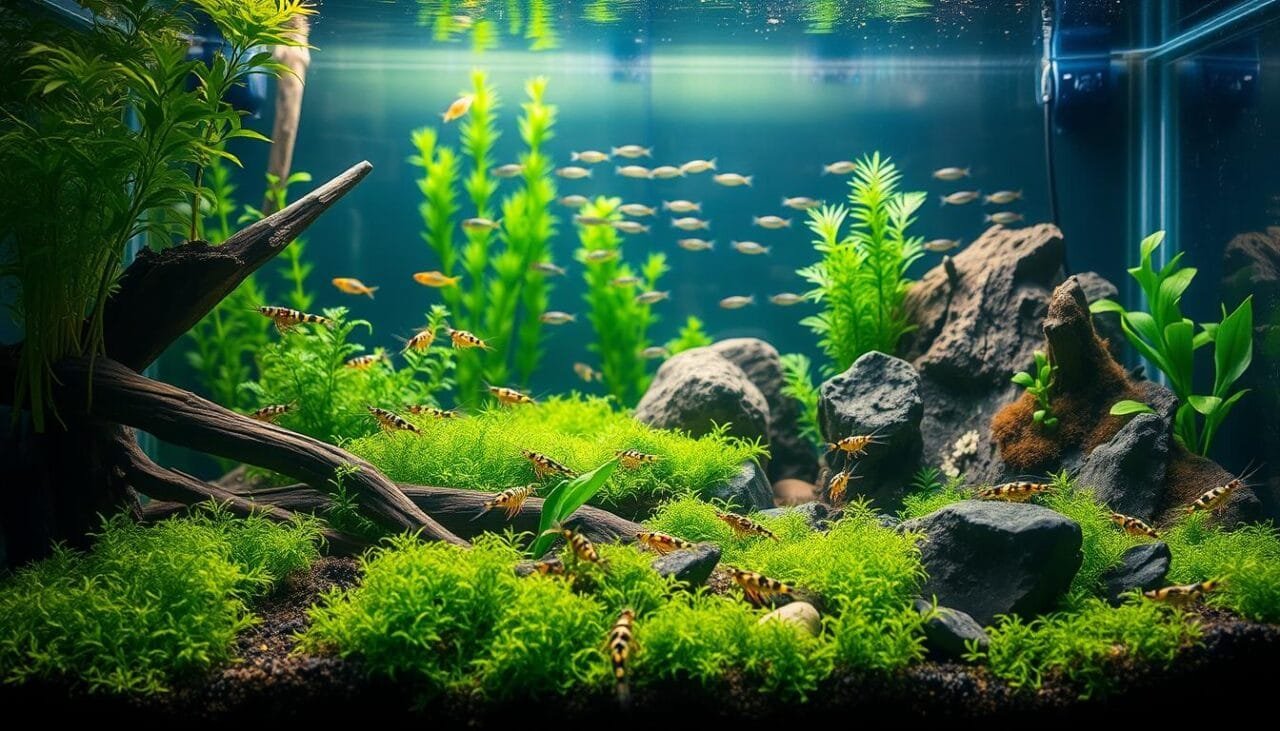
Choosing the right tank mates for Pinto Shrimp is key. These shrimp live best in environments where they don’t fight over space.
“The key to a successful shrimp community is understanding their delicate nature and how they interact.”
Recommended Compatible Species
- Otocinclus catfish (100% safe with shrimp)
- Dwarf rasboras (Boraras brigittae, B. merah, B. maculatus)
- Small, peaceful top-feeders
- Peaceful bottom-dwelling species
Species to Avoid
- Goldfish
- Large rainbowfish
- Cichlids
- Bettas (inconsistent behavior)
- Dwarf puffers
Keeping a stress-free environment is vital for breeding and keeping shrimp alive. Having predators around can make breeding harder and cause shrimp to hide all the time.
| Tank Mate Category | Compatibility Rating | Potential Risk |
|---|---|---|
| Otocinclus | Excellent | None |
| Dwarf Rasboras | Good | Low |
| Bettas | Variable | High |
| Cichlids | Poor | Very High |
When deciding on tank mates, remember the peaceful nature and vulnerable characteristics of Pinto Shrimp. A setup with just their species is usually the best choice for these interesting creatures.
Color Variants and Pattern Grading
Pinto Shrimp fans love the colorful world they live in. These freshwater friends show off many colors, making them a favorite among aquarium lovers.
Exploring Color Morphs
The Galaxy Pinto shrimp family has many colors to see. You can find:
- Black base colors
- Red base colors
- Yellow base colors
Understanding Grading Systems
Color grading uses a special scale to judge the shrimp’s looks. The scale goes from G3 to G0. Each level shows better color and pattern.
| Grade | Color Characteristics |
|---|---|
| G3 | Lighter colors with transparent areas |
| G2 | More solid and consistent colors |
| G1 | Deep vibrant colors, minimal transparency |
| G0 | Intense colors with flawless uniform appearance |
Maintaining Color Quality
Line breeding and culling are key for keeping colors bright. Breeders pick the best to pass on good traits. They look at carapace patterns, rostrum shape, and pleopods.
Keeping colors bright needs knowing about genetics and smart breeding.
Looking for Pinto Shrimp? You can find cool patterns like Galaxy Fishbone and Stardust varieties. They add beauty and genetic variety to your tank.
Conclusion
Exploring pinto shrimp in freshwater aquariums is a thrilling journey. These creatures add beauty and life to your tank. They come in different colors and are fun to watch.
To care for pinto shrimp, you need to focus on a few key things. This includes the right water conditions and a good diet. Keeping their water soft and slightly acidic is important. Also, make sure their tank is warm enough.
Breeding pinto shrimp requires patience and attention to detail. You need to watch their environment and food closely. This way, you can help them thrive.
Pinto shrimp are more than just pretty to look at. They show us the beauty of nature in a small way. Whether you’re new or experienced, learning about them will make your tank come alive.
Your adventure with pinto shrimp is just beginning. Every time you breed them or see a new color, it’s a victory. Enjoy the journey and watch your tank grow and change.
FAQ
What exactly are Pinto Shrimp?
Pinto Shrimp are special freshwater aquarium shrimp. They have unique and bright colors. They are bred to have cool spots and patterns, making them a favorite among aquarium fans.
How large do Pinto Shrimp typically grow?
Pinto Shrimp are small, growing up to 1-1.5 inches. They fit well in small tanks, making them great for tiny aquariums.
What tank size is recommended for Pinto Shrimp?
Even though they’re small, Pinto Shrimp need a tank of at least 5-10 gallons. Bigger tanks help keep the water stable, which is better for them.
What water parameters do Pinto Shrimp require?
Pinto Shrimp like specific water. They prefer a pH of 6.5-7.5 and a temperature of 70-78°F. They also like moderate water hardness and stable Total Dissolved Solids (TDS) levels.
What do Pinto Shrimp eat?
These shrimp eat biofilm, algae, and plant matter. In tanks, they can also have shrimp pellets, blanched veggies, and special shrimp foods for a balanced diet.
How often do Pinto Shrimp breed?
Pinto Shrimp breed often when conditions are right. Females can carry eggs every 3-4 months. The eggs hatch in 2-3 months, and the young shrimp grow up quickly.
Are Pinto Shrimp difficult to keep for beginners?
Pinto Shrimp need careful care but can be kept by beginners. They need stable water and a well-managed tank. They’re sensitive to water changes, so keeping an eye on the water is important.
What are common health issues for Pinto Shrimp?
Pinto Shrimp can get sick with molting problems, bacterial infections, and stress. They’re very sensitive to copper and sudden changes in water. Keeping the water quality good is key to their health.
Can Pinto Shrimp live with other fish?
It’s best to keep Pinto Shrimp alone or with very calm, small creatures. Most fish are too big or might eat the shrimp.
How long do Pinto Shrimp typically live?
With the right care, Pinto Shrimp can live 1-2 years. Good water, food, and less stress help them live longer and healthier.
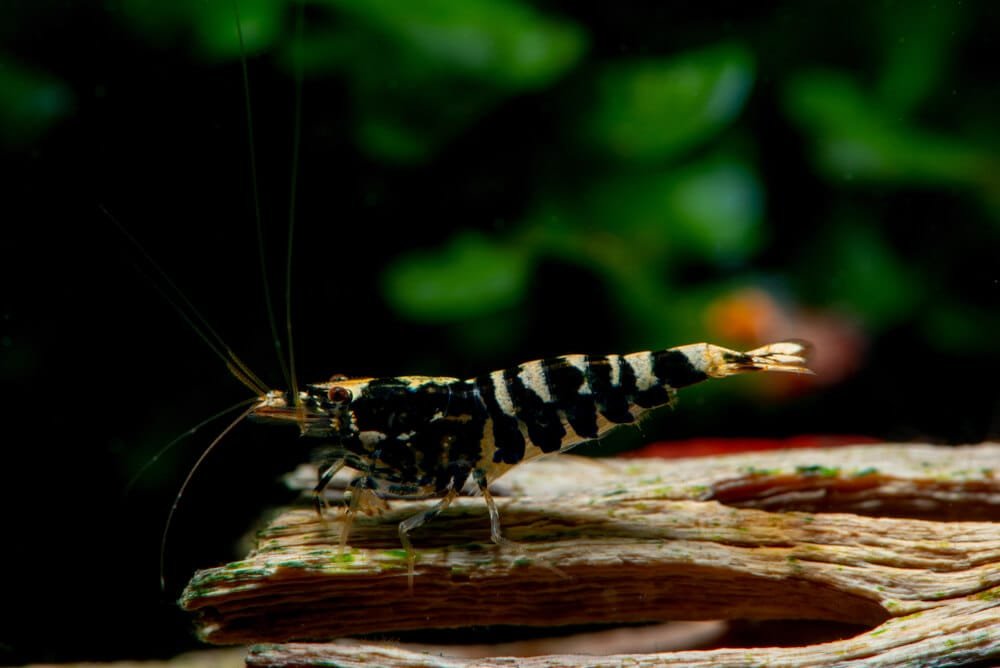
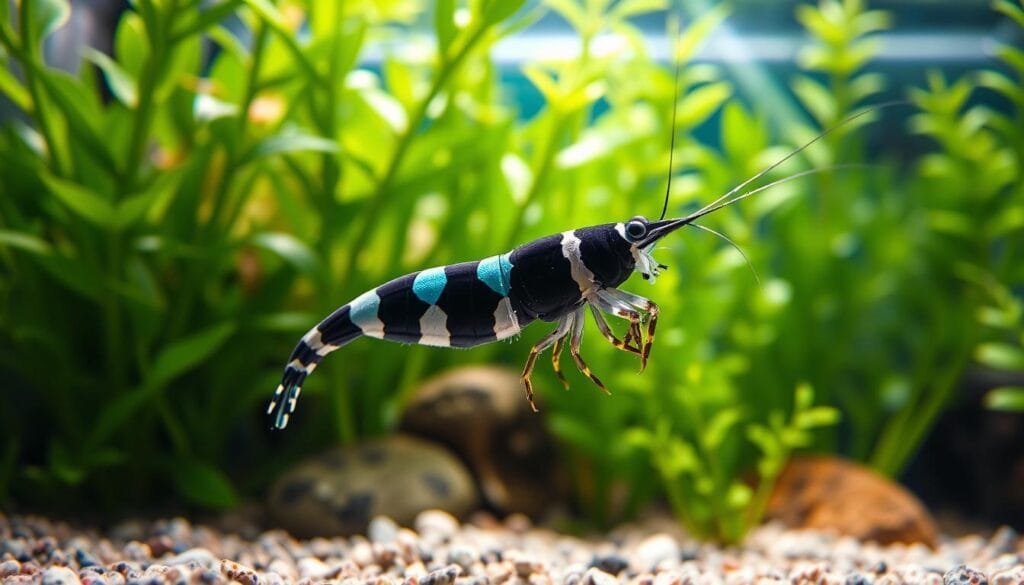 Feeding and Nutrition Guidelines
Feeding and Nutrition Guidelines